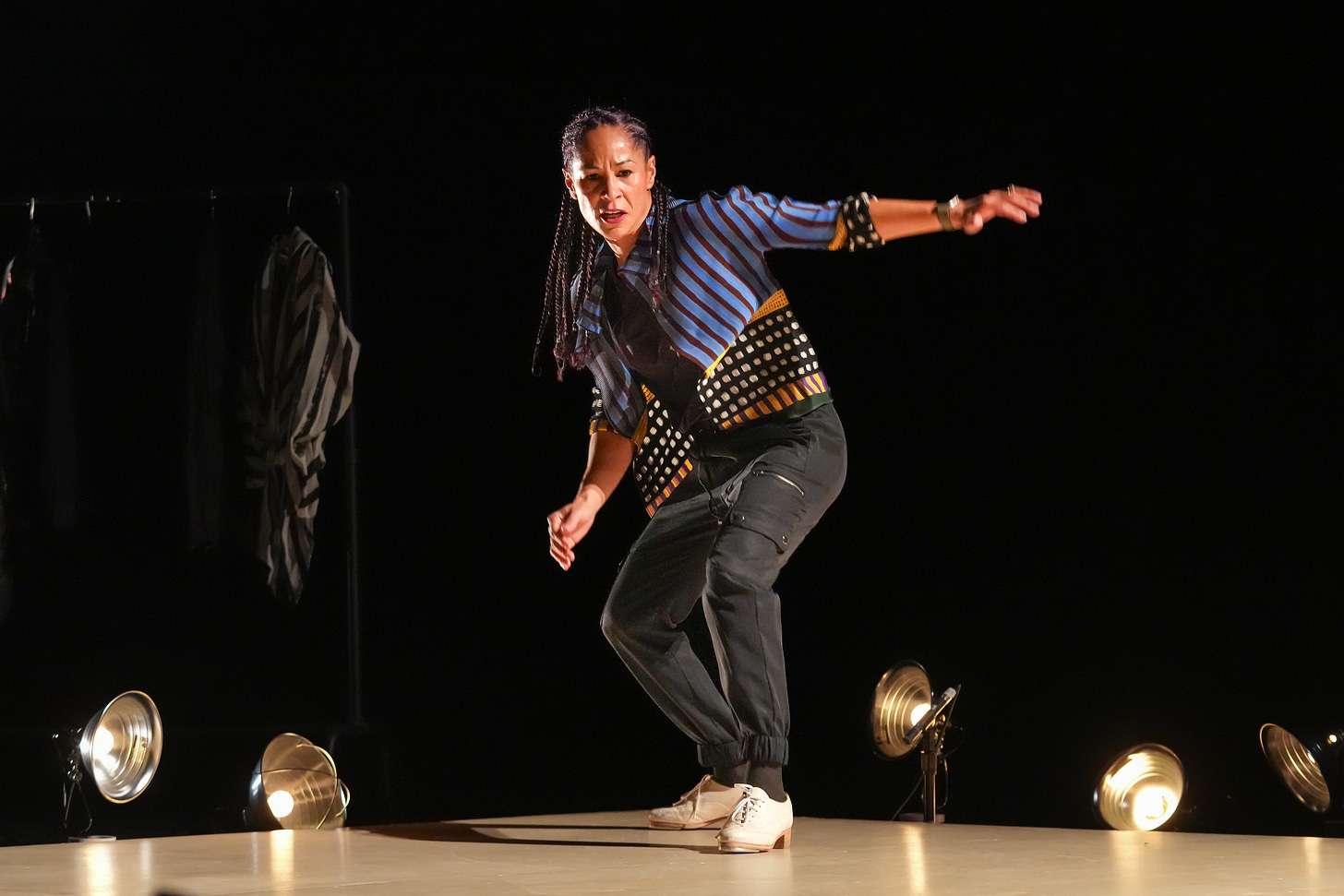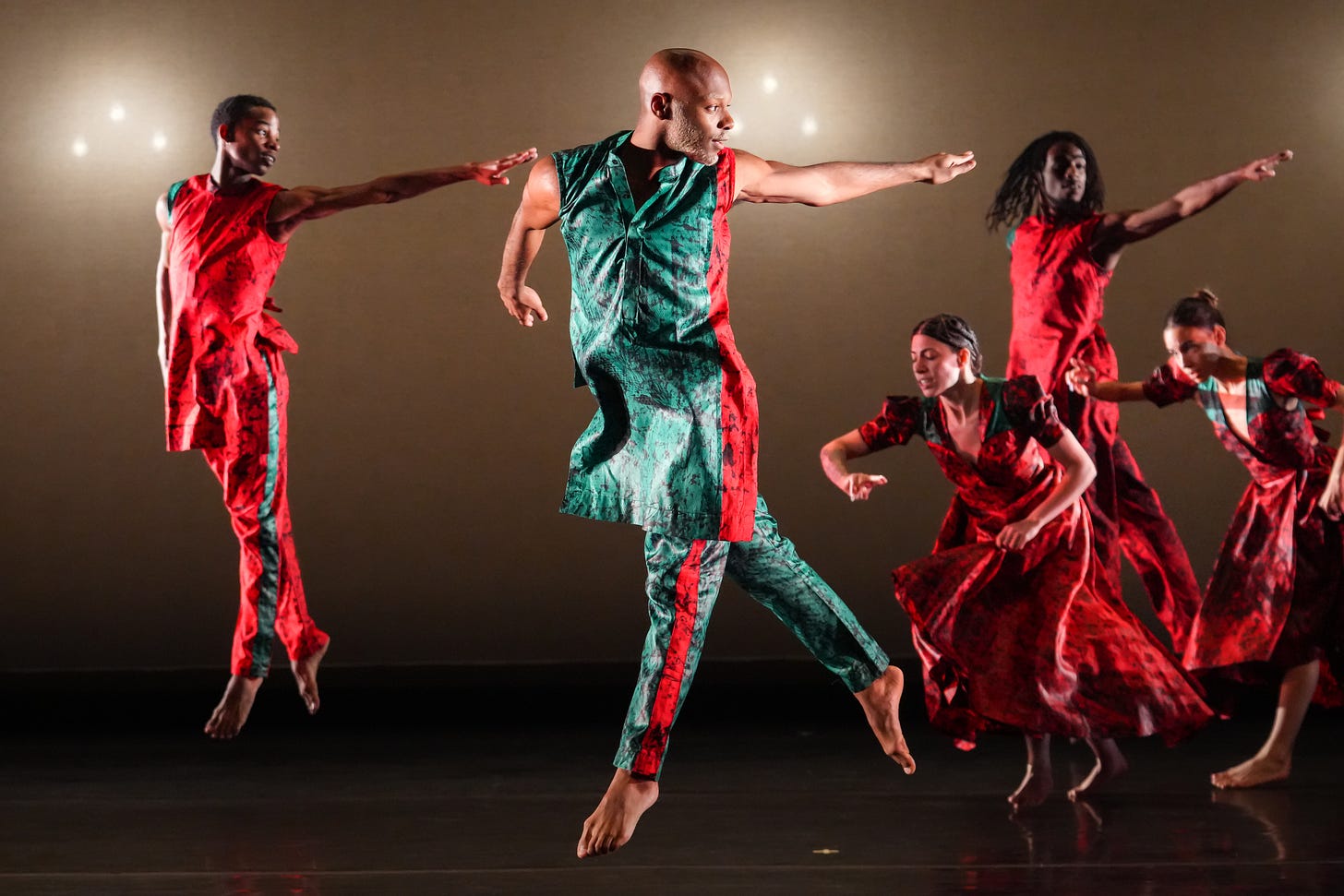Max Roach
Many landscapes of rhythm were on display this week at The Joyce in the program “Max Roach 100,” a tribute to the jazz percussionist, born in 1924. The show, produced by the Joyce and put together by Richard Colton—founder of Movement Without Borders at Judson Memorial Church—paired three vastly different recordings by Roach with three choreographers, plus a short film by Kit Fitzgerald. It was one of the most satisfying evenings of dance and music I’ve seen in a while, despite the fact that all the music was taped.
Roach was both an innovator who expanded the rhythmic and textural range of jazz percussion, turning the drum set into a one-man-orchestra, and an avid collaborator who worked with everyone from Dizzy Gillespie to Charlie Parker to Dinah Washington and Thelonius Monk. His interpretation of rhythm was totally elastic, and his improvisational invention endless. He could take the audience through a fantastical sonic journey, with rhythmic structures that expanded and contracted, formed sonic arcs, and layered over each other, introducing one idea after another, seemingly without limits.
It might have seemed tricky to find the right partners to pair with this complex music, but Colton settled on what appear to be just the right interpreters: the tap choreographer Ayodele Casel, hip-hop innovator Rennie Harris, and modern-vernacular dancemaker Ronald K. Brown, the latter in collaboration with Arcell Cabuag. Fitzgerald’s short film, complete with retro-cool visual effects like colored auras and overlapping transparencies, gave a sense of Roach’s focus and range, the way he could coax his drum set to create ever-new sounds, almost as if it were a living being.
The most engrossing match was with tapper Ayodele Casel, who in “Freedom….In Progress” met Roach’s expansive and open-ended improvisations with the pianist Cecil Taylor (1979) with a tap improvisation that opened door after door to new rooms, each full of ideas. Matching Taylor and Roach’s flurries of notes and beats, she created counter-rhythms with her feet, listening, responding, trilling. It would be impossible for me to say how long the improvisation lasted—it seemed both eternal and to pass in the blink of an eye. There was no space for the mind to wander as it followed her arcs of thought into the present of now, and then now, and then now.
Ayodele Casel in “Freedom…in Progress,” photo by Steven Pisano
The complexity of the score required everything of Casel: total concentration, total flow, as she free-associated, exploring this idea and then that. Tapping walks, steps that traveled forward, back, and to the sides, slides, rhythmic clusters, staggers, hops with both feet. It was an improvisation on an improvisation. When it ended, she simply looked up—as if coming up for air—smiled, and walked off, carrying with her the last of the lights. (The others had been dragged off earlier, a witty idea devised by Casel’s co-creator, Torya Beard.)
Rennie Harris’s “Jim Has Crowed,” photo by Steven Pisano
This was a hard act to follow. But Rennie Harris’s “Jim Has Crowed,” for 12 dancers, brought its own strengths to the table: intensity, virtuosity, speed. The piece, set to Roach’s “The Dream/It’s Time”—which combines percussion, and then brass, with phrases from Martin Luther King’s “I Have a Dream” speech, is driven by a sense of urgency. The dancers seem to be dancing for their lives, in both their movement quality, their gestures, and their expressions. Harris’s hip-hop vocabulary fits exceptionally well with Roach’s bursts of rhythm in the score, feet flying and bodies whipping and bending to Roach’s fluttering beats. In the midst of this ferocious activity, in which several things seem to always be happening at once, gestures of protest, raised fists, screaming mouths, lips forming words, return again and again. All is not well. The dancers look out at the audience, and then back at each other. Even in the ensemble, they are individuals, a few of whom launch into thrilling solos: flips, spins, super-fast feet, dancing on the floor. One woman matches the silvery scream of the trumpet, the force of her limbs cutting through the air like lightning bolts. Every element of the dance is alight.
Enter Ronald K Brown with his famous sense of flow, paired with Roach’s “Percussion Bitter Sweet,” a 1961 album infused with Afro-Cuban influences. The piece, which Brown—who suffered a stroke in 2022—created in collaboration with his associate director, Arcell Cabuag, was made for the dancers of his own company (Evidence) and the Cuban troupe Malpaso. It is like a primer in Brown’s infectious spirit and movement style, its fluidity and fullness, the waves of warmth that emanate from the stage, the ease in moving dancers in and out of the wings. The vocabulary combines African dance with American modern dance and Black popular dance to form an infectious hybrid that makes the bodies of the dancers appear to both float and dig into the ground at once. Impulses course through them from head to toe. The entire body dances. I’m always amazed by the way the dancers use their shoulders and backs, so that they seem to scoop the movement out of the air.
Auston Warren Coats with dancers from Ronald K. Brown and Malpaso in “Percussion Bitter Sweet: Tender Warriorsm,” photo by Steven Pisano
The dancers from the Evidence company have this quality ingrained in them; I could watch the tall, statuesque Joyce Edwards, with her regal and easy grace, for hours. It comes less readily to the Malpaso dancers, beautiful and elegant as they are. The contrast creates a slight dissonance in the ensembles—you can almost pick out the dancers that haven’t quite gotten the groove into their muscles. But the overall effect is one of generosity and pleasure. The pleasure of dancing together, of feeling the music sink under the skin, of allowing first one rhythm and then another to find expression in the body. Brown and Cabuag’s “Percussion Bitter Sweet: Tender Warriors” is like a late Willem de Kooning, a dance of pure line and luminosity, with nothing left to prove.








Marina certainly knows how to put readers in the theater with her--vivid descriptive writing doesn't even begin to convey what she does here with a vocabulary supported by knowledge. Since I live 3000 miles away from this action (Ronald K. Brown and Rennie Harris have however toured here frequently) I am extremely grateful for this excellent review.
Agreed. A wonderful choice of artists, and a really interesting way of thinking about the music-movement connection.